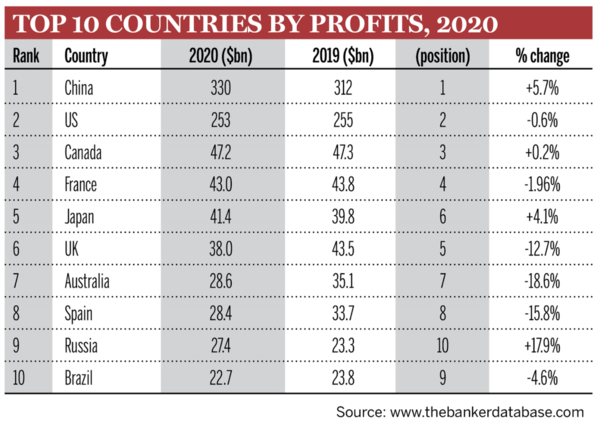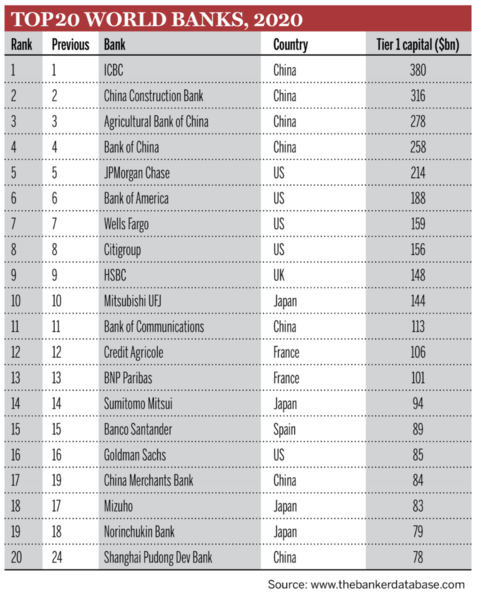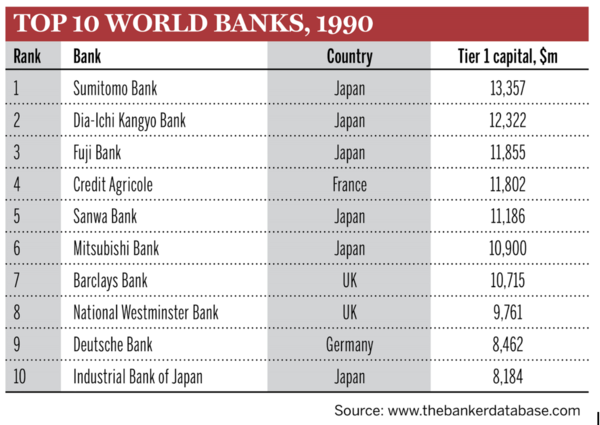1 July 2020: Japanese banks increased their profits by 4%, taking the country from 6th to 5th place, according to The Banker's latest ranking of the Top 1000 World Banks (see Table 1). This was thanks to a 443% rise in Mizuho Financial Group’s profits and despite falls at Japan’s other two leading banks Mitsubishi UFJ and Sumitomo Mitsui.
Brian Caplen, editor of The Banker, said: “Mizuho’s results rebounded after heavy restructuring costs the previous year. Japanese banks now have the fourth highest profits after China, the US and Canada but wisely they are preparing for very tough times ahead. Covid-19 related losses will hit their balance sheets going forwards.”
In the main ranking based on Tier 1 capital – a key measure of banking strength – Mitsubishi UFJ held on to its position as the world’s 10th largest bank (see Table 2) with $144 billion in capital. Sumitomo Mitsui placed 14th with $94 billion and Mizuho 18th with $83 billion. Together these three banks account for 46% of total Japanese banking capital.
Japan has 87 banks in the ranking, accounting for 3.6% of global bank profits. But in terms of return on capital (profitability/Tier 1) Japanese banks fare badly at 4.53%, less than half the global average of 10.52%. This suggests that Japanese banks are well capitalised but do not use their resources as efficiently as banks in the US, for example, where the return on capital is 14.05%.
Nomura Holdings topped the list of the banks making the biggest moves from previous losses back into profits (see Table 3). Last year it lost $340 million. This year it earned $2,284 million. Its Tier 1 capital of $24 billion gave it 78th place in the Top 1000.
This year marks the 50th anniversary of The Banker’s Top 1000 ranking. There were no Japanese banks in the first Top 10 in 1970. But by 1990, at the end of the country’s decade-long asset bubble, Japanese banks held six positions in the Top 10 (see Table 4) including the top three positions. Sumitomo was in first place, followed by Dia-Ichi Kangyo Bank (2nd) and Fuji Bank (3rd).
There followed a huge consolidation in Japanese banking that saw Dia-Ichi Kangyo merged with Fuji and Industrial Bank of Japan to form Mizuho among a number of major tie-ups. Back in 1990 Sumitomo topped the ranking with $13 billion in capital. Today, China’s ICBC tops the ranking with $380 billion making it 29 times larger. Sumitomo is 7 times larger than it was in 1990. Japan’s economy has only expanded by about 50% over the same period showing how much larger today’s consolidated banks are relative to the general economy than was the case 30 years ago.
| TABLE 1 | |
|
| |
| TABLE 2 | |
|
| |
|
TABLE 3 PTP = Pre tax profits Source: www.thebankerdatabase.com | |
| TABLE 4 | |
|
|
-ends-
For more information, please contact Rhonda Taylor / rhonda.taylor@ft.com
About The Banker
The Banker is the world’s premier banking and finance resource, providing global financial intelligence since 1926.
The Banker is the key source of data and analysis for the industry. The Banker’s Top 1000 World Banks ranking has been setting the industry benchmark since 1970, providing comprehensive intelligence about the health and wealth of the banking sector. To find out more visit www.thebanker.com/top1000.
Brian Caplen has been a financial and business journalist for more than 25 years. He has worked in Hong Kong and the Middle East and reported from all over the world. He joined The Banker in 2000 and became editor in 2003.
About the Financial Times
The Financial Times is one of the world’s leading business news organisations, recognised internationally for its authority, integrity and accuracy. The FT has a record paying readership of more than one million, three-quarters of which are digital subscriptions. It is part of Nikkei Inc., which provides a broad range of information, news and services for the global business community.








